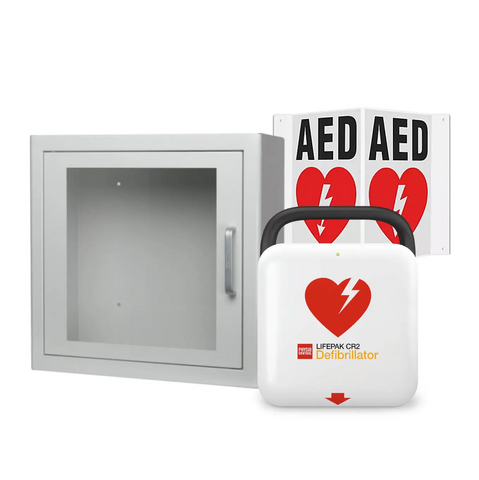
Automated External Defibrillators (AEDs) save lives. Whether in workplaces, schools, or public spaces, businesses, and homes AEDs are essential tools for responding to sudden cardiac arrest (SCA). In Canada, understanding how AEDs work, their accessibility, and legal requirements can empower individuals to act quickly in emergencies.
What Is an AED?
An Automated External Defibrillator is a portable device designed to deliver a controlled electrical shock to the heart. This shock can restore a normal heart rhythm during SCA—a medical emergency in which the heart suddenly stops beating effectively. Without intervention, SCA can result in death within minutes.
Key Features of AEDs:
- User-Friendly Design: AEDs are designed for use by non-medical personnel, with voice prompts and visual instructions guiding users.
- Automatic Shock Delivery: AEDs analyze the heart’s rhythm and decide if a shock is needed, ensuring safety for the victim and responder.
- Portable and Lightweight: Most AEDs are compact and easy to transport, making them suitable for various locations.
AED Accessibility in Canada
Canada has made significant strides in making AEDs widely available. Public access to AEDs is critical in improving survival rates for out-of-hospital cardiac arrests.
Where Are AEDs Found in Canada?
- Public Spaces: Airports, malls, sports arenas, and community centers often have AEDs.
- Workplaces: Many Canadian employers are incorporating AEDs into their health and safety plans.
- Schools: Provinces like Ontario mandate AEDs in schools to ensure children and staff have access.
Legal Requirements
While AED regulations vary by province, many jurisdictions encourage or mandate their placement in high-traffic areas. For example:
- Ontario: Under the Defibrillator Access Act (2020), public buildings and some private building will be required to have AEDs installed and accessible.
- Manitoba: AEDs are required in fitness centers and sports venues. Check your local provincial guidelines to stay compliant.
Why AEDs Are Essential
Sudden Cardiac Arrest in Canada
- Statistics: Over 50,000 cardiac arrests occur annually in Canada.
- Survival Rates: Chances of survival decrease by 7-10% for every minute without defibrillation. AEDs can significantly improve these odds when used promptly.
AEDs vs. CPR
While Cardiopulmonary Resuscitation (CPR) helps maintain blood flow to vital organs, defibrillation is necessary to restart the heart. AEDs are a critical component of the Chain of Survival, which includes:
- Recognizing the emergency and calling 911.
- Starting CPR.
- Early defibrillation with an AED.
- Advanced medical care.
How to Use an AED
Using an AED may seem intimidating, but the process is straightforward. Follow these steps:
- Turn on the AED: Open the device and follow voice/visual prompts.
- Attach Pads: Place the adhesive pads on the victim's chest as shown in the diagrams provided.
- Analyze Rhythm: The AED will automatically check the heart's rhythm.
- Deliver Shock: If instructed, press the shock button (some AEDs deliver shocks automatically).
- Continue CPR: After the shock, perform CPR until help arrives or the AED advises another shock.
Training Opportunities
While AEDs are designed for anyone to use, training through courses like CPR/AED Certification can increase confidence and efficiency during emergencies. Organizations like the Canadian Red Cross and Heart and Stroke Foundation offer these programs.
Funding and Community AED Programs
Cost is a barrier for many organizations and communities. Fortunately, several programs and grants in Canada support AED installation:
- Heart and Stroke Foundation’s AED Program: Provides funding and resources for AED placement.
- Provincial Initiatives: Some provinces offer subsidies for AEDs in public buildings.
- Corporate Sponsorships: Businesses often partner with local organizations to fund AEDs in underserved areas.
Maintaining AEDs
To ensure AEDs are ready in emergencies:
- Inspect Regularly: Check battery life and electrode pad expiration dates.
- Follow Manufacturer Guidelines: Perform routine maintenance as outlined.
- Keep AEDs Visible: Place AEDs in accessible, well-marked locations.
Conclusion: AEDs Save Lives
The presence of an AED can mean the difference between life and death. In Canada, widespread access and awareness are critical to improving survival rates for cardiac emergencies. By understanding how to use an AED and advocating for their placement in your community, you can contribute to a safer, healthier environment for all.
Whether you're a business owner, educator, or concerned citizen, consider the impact an AED can have in your space. Take action today and be prepared to save a life tomorrow. Contact AED.ca for any questions
AED where to buy an aed in canada aeds aed for sale aed in canada aed machine zoll aed zoll aed 3 zoll plus aed






